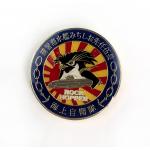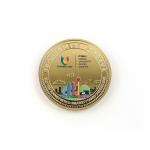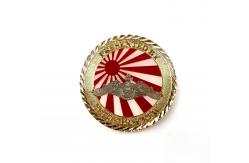Manufacturing challenge coins involves several steps that combine
design, material selection, and production techniques. Here's a
comprehensive guide to the process: 1. Concept and DesignPurpose and Theme: Determine the purpose of the coin (e.g., military, corporate,
commemorative) and the theme or message it should convey.Design Creation: Create detailed artwork. This includes deciding on:Shape and Size: Common sizes range from 1.5" to 3" in diameter, but custom shapes
are possible.Details and Text: Include any logos, symbols, text, and dates.Color Scheme: Decide on the use of colors (enamel fills) and finishes (e.g.,
antique, polished).
2. Digital Rendering- Graphic Design Software: Use software like Adobe Illustrator or CorelDRAW to create a
digital proof. This helps in visualizing the final product and
making necessary adjustments.
3. Material SelectionBase Metals: Common choices include brass, copper, zinc alloy, and
nickel-silver.Plating Options: Options include gold, silver, nickel, bronze, or antique finishes.
4. Production MethodsDie Striking: For a crisp and detailed design, a die (stamp) is created and used
to strike the metal blank.Casting: For more complex designs or 3D effects, molten metal is poured
into a mold.
5. Die CreationEngraving the Die: An engraving machine or hand-engraving is used to create a steel
die with the coin's design.Die Hardening: The die is heat-treated to increase its durability.
6. Coin Blanking and StrikingCutting Blanks: Metal sheets are cut into blank discs of the desired coin size.Striking the Blanks: The blank discs are struck with the die to imprint the design.
7. Trimming and ShapingEdge Trimming: Excess metal around the edge of the coin is trimmed off.Edge Design: If the coin includes edge text or patterns, these are added at
this stage.
8. Plating and FinishingPlating: The coins are plated with the chosen finish. This can involve
dipping the coins in a solution containing the plating metal.- Polishing: Polished to achieve a smooth, shiny surface, or left with an
antique finish for a more rustic look.
9. Color Application
Enameling: Colors are applied to recessed areas of the coin using soft or
hard enamel. The enamel is then baked to set it.Cleaning: Excess enamel is cleaned off to ensure a neat appearance.
10. Quality ControlInspection: Each coin is inspected for defects, ensuring it meets quality
standards.Corrections: Any necessary touch-ups or corrections are made.
11. PackagingIndividual Packaging: Coins are often packaged in protective cases or pouches to prevent
damage.Bulk Packaging: For larger orders, coins can be packaged in bulk, often wrapped in
protective material.
12. DeliveryShipping: The final step is shipping the completed coins to the client.
Key Considerations:Budget: Higher detail and custom features can increase costs.Lead Time: Complex designs and larger orders require more time to produce.Supplier: Work with reputable manufacturers to ensure high quality.
By following these steps, you can successfully manufacture
high-quality challenge coins that meet your specific requirements. |









